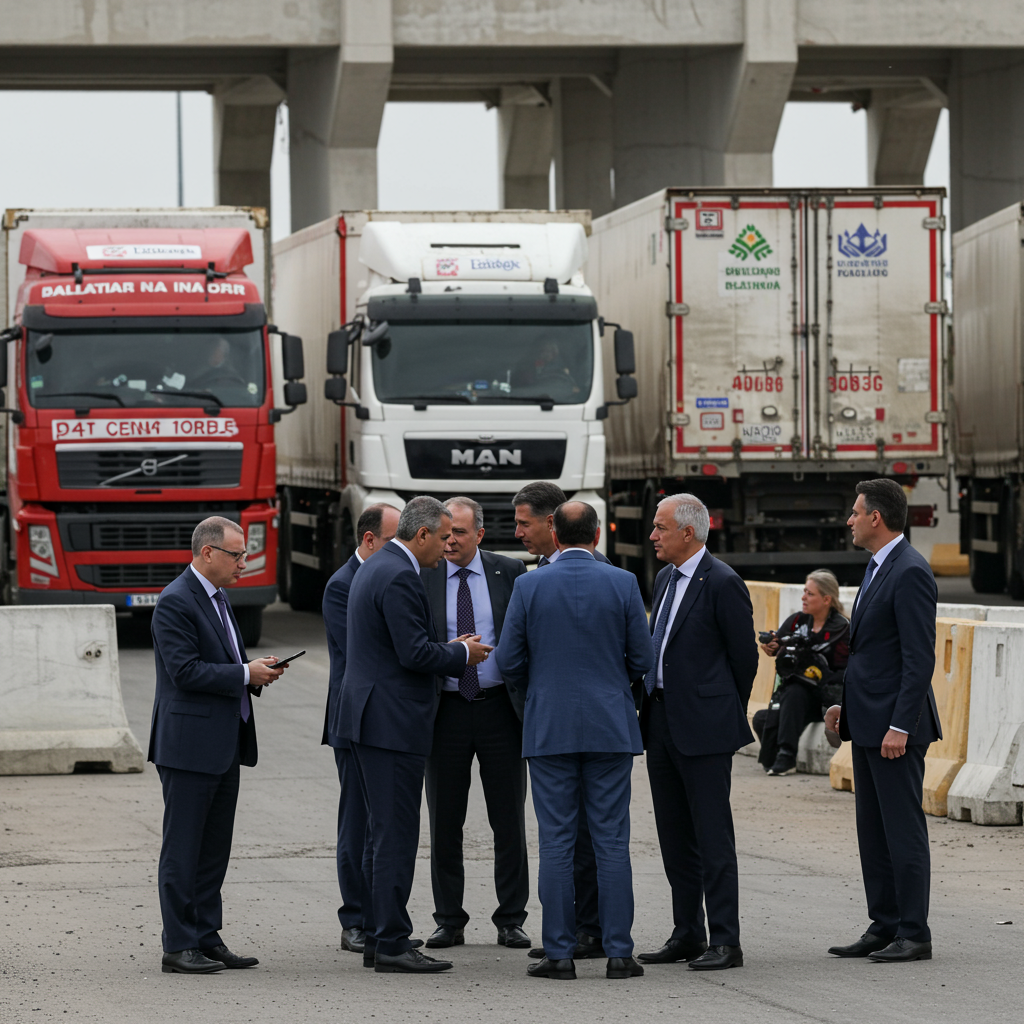The fragile ceasefire in Gaza faces immense pressure, with critical humanitarian aid deliveries reduced and delayed amidst ongoing complexities surrounding hostage returns. International bodies and aid organizations are sounding alarms over the escalating crisis, emphasizing that aid should never be a political bargaining chip. This volatile situation underscores a deeper struggle, as political leaders grapple with the future of the region and the immense human cost of prolonged conflict.
Escalating Humanitarian Crisis: Gaza Aid Under Duress
A severe humanitarian crisis grips Gaza, exacerbated by recent decisions to limit the entry of essential supplies. The United Nations and numerous aid groups report a significant reduction in humanitarian aid trucks allowed into the enclave. Israel has explicitly informed the UN that the expected volume of aid trucks, including vital fuel shipments, will be curtailed or postponed. This decision is directly linked to Hamas’s perceived slow release of deceased hostage remains, a key stipulation of the ceasefire agreement.
Humanitarian organizations, including UNICEF and Medical Aid for Palestinians (MAP), have vehemently condemned this restriction. They argue that facilitating aid is a legal obligation under international humanitarian law, not a negotiable term. Fikr Shalltoot, MAP’s Gaza director, described the situation as “frankly outrageous,” warning of “more avoidable deaths and deprivation” for hundreds of thousands of Palestinians. Even when aid trickles in, damaged infrastructure, limited fuel, and internal distribution challenges severely impede access to displaced populations. The World Food Programme reported fewer than a third of the agreed-upon 600 daily aid trucks have entered Gaza recently, highlighting the critical shortfall.
Aid as a Bargaining Chip: Ethical and Legal Concerns
The deliberate restriction of Gaza aid as leverage has ignited fierce debate. Humanitarian leaders stress that withholding aid from civilians is never acceptable. UNICEF spokesperson Tess Ingram firmly stated, “aid is a legal obligation.” This sentiment is echoed by the UN Emergency Relief Coordinator, Tom Fletcher, who cautioned against “further setbacks” to humanitarian scale-up. The ongoing challenges at border crossings remain a primary impediment, with calls for them to open fully and consistently.
Hostage Returns and Identified Casualties Amidst Fragile Truce
The return of both living and deceased hostages remains a central, emotionally charged aspect of the ceasefire. Recent days have seen a partial return of deceased hostages, with the International Committee of the Red Cross (ICRC) facilitating transfers from Gaza to Israel. While initial hopes for swift returns were high, Hamas has so far released only a fraction of the remaining deceased hostages required under the deal. Families in Israel endure agonizing waits for official identification, urging public sensitivity during this profoundly difficult time.
Personal Stories of Survival and Loss
The human toll of captivity is starkly illustrated by the stories emerging from the conflict. Idit Ohel, mother of recently freed hostage Alon Ohel, shared her son’s harrowing experience and profound gratitude. Alon, abducted from the Nova music festival, spent over two years in captivity, suffering severe injuries, including vision loss. His recovery journey involves amateur-stitched wounds and ongoing pain from shrapnel. Idit Ohel credited the hostage deal with saving his life and called for national unity, urging Israelis to move beyond hatred and focus on rebuilding.
Tragically, others did not survive. Guy Illouz, a 26-year-old sound technician also kidnapped from the Nova festival, was among the deceased hostages returned. His funeral drew huge crowds, mourning a life cut short. Illouz reportedly sustained injuries during his abduction and died in captivity due to neglected medical care. These personal narratives underscore the immense suffering and loss endured by families on all sides.
Political Tensions and the Future of the Ceasefire
The path forward for the ceasefire is riddled with political complexities and deep-seated disagreements. US President Donald Trump signaled a potential return to military action if Hamas fails to uphold its side of the agreement, specifically regarding the complete return of hostages. Speaking to CNN, Trump indicated Israeli forces could resume operations “as soon as I say the word,” emphasizing the importance of securing all hostages.
Israeli Prime Minister Benjamin Netanyahu has also maintained a firm stance, insisting on Hamas’s complete disarmament as a prerequisite for any lasting peace. In an interview with CBS, Netanyahu stated Israel “will disarm” Hamas if they refuse to do so voluntarily. He also emphasized the necessity of preventing weapons manufacturing and smuggling into Gaza.
Disparate Visions for Peace and Reconstruction
The vision for a sustainable peace remains highly contentious. Dr. Mustafa Barghouti, leader of the Palestinian National Initiative, criticized the US-brokered plan, arguing it falls short of being a “real peace plan.” He asserted that true reconciliation requires Palestinians to be “free from occupation” and “Israeli apartheid,” alongside the creation of an independent, sovereign Palestinian state. Netanyahu, conversely, has consistently opposed the creation of a Palestinian state.
Unresolved issues, such as Hamas’s disarmament, the potential for an international stabilization force, and the eventual withdrawal of Israeli forces from Gaza, highlight the profound ideological chasm separating the parties. Experts like HA Hellyer of the Royal United Services Institute describe claims of a “historic dawn” in the Middle East as “aspirational,” contingent on significant, sustained effort from the United States and a willingness from Israel to allow genuine change.
Gaza’s Internal Security and Civilian Impact
Beyond the aid crisis and political posturing, Gaza faces severe internal security challenges and a dire humanitarian situation for its civilian population. Recent days have seen violent clashes erupt between Hamas and rival groups in several areas across Gaza, raising concerns about stability following Israel’s partial withdrawal. The US Central Command (CENTCOM) chief, Adm. Brad Cooper, urged Hamas to immediately cease “violence and shooting at innocent Palestinian civilians.” He also called on Hamas to disarm and adhere to the “20-point peace plan,” referring to the framework for a lasting ceasefire.
The UN Human Rights Office has also raised alarms, reporting that the Israeli military “continues to kill civilians” in redeployed areas within Gaza, with at least 15 Palestinians reportedly shot and killed in these zones since early October. These reports contribute to a climate of fear and insecurity among residents.
The Hidden Toll: Recovered Bodies and Unanswered Questions
The devastating toll on civilian lives continues to unfold. Recovery operations in Gaza have unearthed numerous bodies from the rubble following the ceasefire. According to the Gaza health ministry, over 250 bodies have been recovered since the truce began. In a separate development, Israel has transferred the bodies of 90 deceased Palestinians, previously held during the conflict, back to Gaza.
Medical teams at Nasser Hospital in Khan Younis reported disturbing details regarding some of these returned bodies, noting they arrived “with their hands and legs cuffed,” some blindfolded, and with signs of gunshot wounds or injuries consistent with being run over by tanks. The circumstances surrounding their deaths remain largely unclear, prompting calls for investigation. This complex and tragic aspect adds another layer of suffering to an already devastated population struggling with a lack of housing, food, and water as winter approaches.
Frequently Asked Questions
Why is humanitarian aid to Gaza being restricted?
Humanitarian aid to Gaza is currently restricted due to Israel’s stated policy linking aid deliveries to Hamas’s compliance with the ceasefire deal. Specifically, Israel has reduced or delayed aid trucks in response to what it perceives as a slow return of deceased hostage remains by Hamas. This decision has been widely criticized by international humanitarian organizations, which emphasize that providing aid is a legal obligation under international law and should not be used as a bargaining chip.
Who are the key international organizations facilitating aid and hostage exchanges in Gaza?
Several key international organizations are involved in facilitating aid deliveries and hostage exchanges in Gaza. The United Nations (UN) and its agencies, such as UNICEF and the World Food Programme (WFP), are central to coordinating and distributing humanitarian aid. The International Committee of the Red Cross (ICRC) plays a crucial role in mediating and facilitating the transfer of hostages and deceased individuals between parties. These organizations work to ensure aid reaches those in need and uphold humanitarian principles amidst the conflict.
What are the long-term challenges for Gaza’s recovery after the ceasefire?
Gaza faces immense long-term challenges for recovery, encompassing economic, social, and psychological dimensions. Economically, widespread destruction of infrastructure, homes (over 430,000 damaged or destroyed), and livelihoods means massive reconstruction efforts are needed. Socially, the persistent displacement of people, lack of essential services like clean water and healthcare, and internal security issues (e.g., clashes between rival groups) pose significant obstacles. Psychologically, the trauma of prolonged conflict will affect generations, requiring extensive mental health support. Additionally, deep political divisions over Gaza’s future governance and the creation of a Palestinian state complicate any lasting recovery.
Conclusion
The situation in Gaza remains acutely fragile, marked by a humanitarian crisis driven by aid restrictions and the profound emotional weight of ongoing hostage negotiations. Political leaders like Trump and Netanyahu articulate firm stances on disarmament and compliance, while Palestinian voices call for self-determination and an end to occupation. Amidst this complex geopolitical landscape, the immense human suffering of civilians, grappling with insecurity, loss, and the struggle for basic necessities, stands as a stark reminder of the urgent need for a lasting and just resolution. The world watches as the tenuous ceasefire continues to be tested, with the fate of millions hanging in the balance.
Word Count Check: 1195 words


